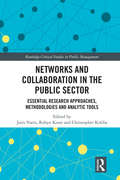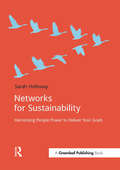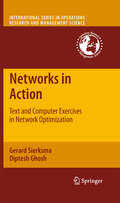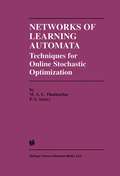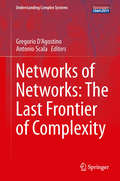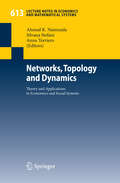- Table View
- List View
Networks and Collaboration in the Public Sector: Essential research approaches, methodologies and analytic tools (Routledge Critical Studies in Public Management)
by Joris Voets Robyn Keast Christopher KolibaNetworks and other collaborations are central to the public sector’s ability to respond to their diverse responsibilities, from international development and regional governance, to policy development and service provision. Great strides have been made toward understanding their formation, governance and management, but more opportunities to explore methodologies and measures is required to ensure they are properly understood. This volume showcases an array of selected research methods and analytics tools currently used by scholars and practitioners in network and collaboration research, as well as emerging styles of empirical investigation. Although it cannot attempt to capture all technical details for each one, this book provides a unique catalogue of compelling methods for researchers and practitioners, which are illustrated extensively with applications in the public and non-profit sector. By bringing together leading and upcoming scholars in network research, the book will be of enormous assistance in guiding students and scholars in public management to study collaboration and networks empirically by demonstrating the core research approaches and tools for investigating and evaluating these crucially important arrangements.
Networks and Foreign Markets: How Relationships Shape the SME's Internationalization Process
by Isabel Díez Vial Marta Fernández-OlmosThis edited volume explores the process by which SMEs internationalize. It discusses the importance of domestic and international networks for firms’ activities and business performance. Offering vast empirical evidence from different industries, the book begins with a theoretical overview of internationalization and networks and goes on to examine the value of knowledge as provided by both domestic networks (i.e. the networks that a firm develops with providers, clients, competitors, local institutions and multinationals), and international network (i.e. business networks, venture capital firms, and global value chains) where the firm is able to use international contacts as a bridge for further development. Offering a valuable contribution on the topic of internationalization, the book also establishes the main implications for practice.
Networks and Groups: Models of Strategic Formation (Studies in Economic Design)
by Bhaskar Dutta Matthew O. JacksonWhen Murat Sertel asked us whether we would be interested in organizing a special issue of the Review of Economic Design on the formation of networks and groups, we were happy to accept because of the growing research on this important topic. We were also pleasantly surprised at the response to our request for submissions to the special issue, receiving a much larger number of sub missions than we had anticipated. In the end we were able to put together two special issues of insightful papers on this topic. Given the growing interest in this topic, we also decided (with encouragement from Murat) to combine the special issues in the form of a book for wider dissemination. However, once we had decided to edit the book, it was natural to move beyond the special issue to include at least some of the papers that have been influential in the literature on the formation of networks. These papers were published in other journals, and we are very grateful to the authors as well as the journals for permission to include these papers in the book.
Networks and Location: Organizing the Diversified Multinational Corporation for Value Creation
by A. GoerzenBased on data from Japan, the book examines the combined effect of product, geographic, and network diversity on multinational enterprise performance. A new measure for geographic scope is developed, one that considers the related elements of international asset dispersion and country environment diversity. The book also introduces a new concept of network diversity, and examines how it is strategically linked to performance. Perhaps most importantly, the book is able to empirically and theoretically demonstrate that a larger, more diverse network of alliances is not necessarily a good idea. These are important findings, with far reaching implications for practice and theory.
Networks for Grid Applications: Second International Conference, GridNets 2008, Beijing, China, October 8-10, 2008. Revised Selected Papers (Lecture Notes of the Institute for Computer Sciences, Social Informatics and Telecommunications Engineering #2)
by Pascale Vicat-Blanc Primet Tomohiro Kudoh Joe MambrettiThis book constitutes the thoroughly refereed post-conference proceedings of the Second International Conference on Networks for Grid Applications, GridNets 2008, held in Beijing, China in October 2008. The 19 revised full papers presented together with 4 invited presentations were carefully reviewed and selected from 37 submissions. The papers address the whole spectrum of grid networks, ranging from formal approaches for grid management to case studies in optical switching.
Networks for Pervasive Services: Six Ways to Upgrade the Internet (Lecture Notes in Electrical Engineering #92)
by Antonio Liotta George ExarchakosReaders will progress from an understanding of what the Internet is now towards an understanding of the motivations and techniques that will drive its future.
Networks for Social Impact
by Michelle Shumate Katherine R. CooperA broad review of how nonprofits, businesses, and governments work together to tackle social problems Networks for Social Impact takes a systems approach to explain how and when networks make a social impact. Michelle Shumate and Katherine R. Cooper argue that network design and management is not a one-size-fits-all formula. Instead, they show that the type of social issue, the mechanism for social impact, environment, and resources available each determine appropriate choices. Drawing on research from public administration, psychology, business, network science, social work, and communication, this book synthesizes what we know about how to best design and manage networks. It includes illustrations from thirty original case studies which describe groups of organizations addressing issues such as gender-based violence, educational outcomes, senior care, veterans' services, mental health and wellness, and climate change. Additionally, the volume examines critical issues that leaders address in creating and managing networks, including social issue analysis, network governance, securing and managing funding, dealing with power and conflict, using data effectively, and managing change. Each chapter includes tools for network leaders to use to handle these issues. This book is neither an overly idealistic, pro-collaboration account of the benefits of network approaches, nor is it a critical view of these efforts. Instead, this clear and concise volume highlights the opportunities and challenges of networks.
Networks for Social Impact
by Michelle Shumate Katherine R. CooperA broad review of how nonprofits, businesses, and governments work together to tackle social problems Networks for Social Impact takes a systems approach to explain how and when networks make a social impact. Michelle Shumate and Katherine R. Cooper argue that network design and management is not a one-size-fits-all formula. Instead, they show that the type of social issue, the mechanism for social impact, environment, and resources available each determine appropriate choices. Drawing on research from public administration, psychology, business, network science, social work, and communication, this book synthesizes what we know about how to best design and manage networks. It includes illustrations from thirty original case studies which describe groups of organizations addressing issues such as gender-based violence, educational outcomes, senior care, veterans' services, mental health and wellness, and climate change. Additionally, the volume examines critical issues that leaders address in creating and managing networks, including social issue analysis, network governance, securing and managing funding, dealing with power and conflict, using data effectively, and managing change. Each chapter includes tools for network leaders to use to handle these issues. This book is neither an overly idealistic, pro-collaboration account of the benefits of network approaches, nor is it a critical view of these efforts. Instead, this clear and concise volume highlights the opportunities and challenges of networks.
Networks for Sustainability: Harnessing people power to deliver your goals
by Sarah HollowayIf your company has an ambitious set of sustainability goals, you’ll already know that they can’t be achieved from the safety of global headquarters. What you need is a network: a small army of people from across the business who know their department, country or brand inside out, and who can find the right way to embed sustainability. Change, when it happens, is usually driven locally, taking into account the priorities, environment and culture of each business area. If you’ve spent a long time persuading senior management that the sustainability agenda is business-critical, it’s difficult to place the delivery of your precious goals in the hands of others. But you can’t be everywhere at once! Networks for Sustainability gives you the tools to review and improve your sustainability network, whether you’re revitalizing a group of champions or setting up your network from scratch.
Networks in Action: Communication, Economics and Human Knowledge
by David Batten John Casti Roland Thordfifteen countries in Scandinavia, Europe, Asia, Australia, and U.S.A. All of them came to Stockholm primarily because they recognize the growing im portance of networks as complex systems, and their home institutions do not offer any systematic lectures on this topic. The Networks Course was originally initiated jointly by the Summer University of Southern Stockholm Foundation and the County Council of Stockholm, the Swedish Aviation Administration, the Swedish National Road Administration, the Swedish Post, the Swedish State Railways, and Telia AB. They have all served as joint sponsors and hosts for the Course. In the year 1993 the Course also was sponsored by the Swedish Transport and Communications Research Board. All these organizations have supported the publication of a series of key lectures from the Course, to be released as a single volume entitled Networks in Action. It is the ambition of the Foundation to create continuity in its activities for the future. The board has proposed to its principals to take a decision in this direction. It is my expectation that this will be the case for the Networks Course from 1995. This book will then serve as a basic reference for use in an era when the topic of Communication-Networks will be included on a permanent basis in the Summer University's agenda.
Networks in Action: Text and Computer Exercises in Network Optimization (International Series in Operations Research & Management Science #140)
by Gerard Sierksma Diptesh GhoshOne of the most well-known of all network optimization problems is the shortest path problem, where a shortest connection between two locations in a road network is to be found. This problem is the basis of route planners in vehicles and on the Internet. Networks are very common structures; they consist primarily of a ?nite number of locations (points, nodes), together with a number of links (edges, arcs, connections) between the locations. Very often a certain number is attached to the links, expressing the distance or the cost between the end points of that connection. Networks occur in an extremely wide range of applications, among them are: road networks; cable networks; human relations networks; project scheduling networks; production networks; distribution networks; neural networks; networks of atoms in molecules. In all these cases there are “objects” and “relations” between the objects. A n- work optimization problem is actually nothing else than the problem of ?nding a subset of the objects and the relations, such that a certain optimization objective is satis?ed.
Networks in Aviation: Strategies and Structures
by Philipp GoedekingAviation networks play a critical role in the success of today’s airlines and airports. This book provides insight on all aspects of modern network strategies and structures, ranging from market research to hub design, operations, organization, alliances, benchmarking, and antitrust issues. Considering both the airline and the airport perspectives, the book explains the economics of connectivity or productivity-driven hub structures through basic mathematics, which helps the reader to comprehend the structural strengths and weaknesses of aviation networks. More than 100 charts help clarify the topics at hand.
Networks in International Business: Managing Cooperatives, Franchises and Alliances (Contributions to Management Science)
by George Wj Hendrikse Gérard Cliquet Ilir Hajdini Aveed Raha Josef WindspergerThis contributed volume focuses on the management and governance of international business networks (IBN). Specifically, the chapters refer to theoretical, conceptual, empirical, and case study papers from all areas in economics and management of IBN. These include cooperatives, franchising, retail chains, strategic alliances, public-private partnerships and new network forms in the digital economy. This book is ideal for researchers and strategists who are keen to improve their understanding of the latest developments in the field.
Networks in the Knowledge Economy
by Rob Cross Andrew Parker Lisa SassonIn today's de-layered, knowledge-intensive organizations, most work of importance is heavily reliant on informal networks of employees within organizations. However, most organizations do not know how to effectively analyze this informal structure in ways that can have a positive impact on organizational performance. Networks in the Knowledge Economy is a collection of readings on the application of social network analysis to managerial concerns. Social network analysis (SNA), a set of analytic tools that can be used to map networks of relationships, allows one to conduct very powerful assessments of information sharing within a network with relatively little effort. This approach makes the invisible web of relationships between people visible, helping managers make informed decisions for improving both their own and their group's performance. Networks in the Knowledge Economy is specifically concerned with networks inside of organizations and addresses three critical areas in the study of social networks: Social Networks as Important Individual and Organizational Assets, Social Network Implications for Knowledge Creation and Sharing, and Managerial Implications of Social Networks in Organizations. Professionals and students alike will find this book especially valuable, as it provides readings on the application of social network analysis that reflect managerial concerns.
Networks in the Russian Market Economy
by M. LonkilaA PDF version of this book is available for free in open access via the OAPEN Library platform, www.oapen.org. This book examines the significance of networks among the firms operative in the contemporary Russian software industry in the St. Petersburg region.
Networks, Markets, and the Pacific Rim: Studies in Strategy (Japan Business and Economics Series)
by W. Mark FruinDespite the negative press Asian economies have received in connection with the recent financial crisis, their record of spectacular growth over the past few decades remains irrefutable. In an effort to provide a rich, textured analysis of these economies, editor W. Mark Fruin presents a collection of essays that explores the wide range of network organizations that have been established in the Pacific Rim. Conventional studies of economic organization have tended to center on markets and hierarchies, the two forms of organization most common in the West. But today the world moves too quickly and too unpredictably for the idealized organizations of microeconomic theory to keep up. It is no accident that the region that has generated the world's most explosive economic growth is also the region where network organizations--sets of independent actors who cooperate frequently for mutual advantage--are most pervasive. Rapid economic, social, and technical changes favor the formation of network organizations, and vice versa. The contributors to this volume identify and elucidate four basic types of networks: naturally occurring networks, market replacing networks, hierarchy replacing networks, and market enhancing networks. They show how all of these have been shaped by the history, government, legal system, and culture of each country under consideration. These network organizations allow the authors to compare and contrast network forms in China, Japan, South Korea, Taiwan, and the United States according to features such as degrees of formalization, rule definition, and market conformance. The works collected here make an important contribution to a networks-markets- hierarchies framework that recognizes and emphasizes the diversity of organizational forms and behaviors. A unique resource for scholars and professionals in the fields of management and economics, this book enables a complex analysis of one of the world's fastest growing and most theoretically challenging regions.
Networks of Institutions: Institutional Emergence, Social Structure and National Systems of Policies (Routledge Advances in Heterodox Economics #1)
by Shuanping DaiThe questions such as, ‘why the focuses of national policies vary significantly across countries, although their sources of policies are to a great extent identical’; ‘why national development experiences mostly cannot be transplanted successfully among countries’; ‘why some ineffective institutions persist over long periods of time’, have attracted numerous efforts. This book provides a new perspective and argues that the answers lie in the existence of the networks of institutions and thus of national systems of policies (NSP) within national frameworks. Institutions are the equilibria of games and exist as rules of games. Therefore, a basic setting is that institutions emerge endogenously from a series of social interactions, and the interacting human agents are connected and interdependent at the overlapping interaction platforms. National policies and developmental strategies can be modelled in this approach too. The networks of institutions describe the dynamic connected structure among institutions in the process of social interactions over time. Regarding the national policies response to the recent economic crises, this book argues that the difference comes from the distinct understandings of the tags of the policies, which highly depend on the distinct national contexts, such as national interests, cultural background, political systems and so forth. This book represents a significant contribution to the literature which will be essential reading for those interested in institutional economics, network theory, social structures and economic policy. In particular, the approach of applying network game theory in institutional emergence, and the terms developed, i.e. tags of institutions, and national systems of policies, in this book, are illuminating and deserve more attention.
Networks of Institutions: Institutional Emergence, Social Structure and National Systems of Policies (Routledge Advances in Heterodox Economics #1)
by Shuanping DaiThe questions such as, ‘why the focuses of national policies vary significantly across countries, although their sources of policies are to a great extent identical’; ‘why national development experiences mostly cannot be transplanted successfully among countries’; ‘why some ineffective institutions persist over long periods of time’, have attracted numerous efforts. This book provides a new perspective and argues that the answers lie in the existence of the networks of institutions and thus of national systems of policies (NSP) within national frameworks. Institutions are the equilibria of games and exist as rules of games. Therefore, a basic setting is that institutions emerge endogenously from a series of social interactions, and the interacting human agents are connected and interdependent at the overlapping interaction platforms. National policies and developmental strategies can be modelled in this approach too. The networks of institutions describe the dynamic connected structure among institutions in the process of social interactions over time. Regarding the national policies response to the recent economic crises, this book argues that the difference comes from the distinct understandings of the tags of the policies, which highly depend on the distinct national contexts, such as national interests, cultural background, political systems and so forth. This book represents a significant contribution to the literature which will be essential reading for those interested in institutional economics, network theory, social structures and economic policy. In particular, the approach of applying network game theory in institutional emergence, and the terms developed, i.e. tags of institutions, and national systems of policies, in this book, are illuminating and deserve more attention.
Networks of Learning Automata: Techniques for Online Stochastic Optimization
by M.A.L. Thathachar P.S. SastryNetworks of Learning Automata: Techniques for Online Stochastic Optimization is a comprehensive account of learning automata models with emphasis on multiautomata systems. It considers synthesis of complex learning structures from simple building blocks and uses stochastic algorithms for refining probabilities of selecting actions. Mathematical analysis of the behavior of games and feedforward networks is provided. Algorithms considered here can be used for online optimization of systems based on noisy measurements of performance index. Also, algorithms that assure convergence to the global optimum are presented. Parallel operation of automata systems for improving speed of convergence is described. The authors also include extensive discussion of how learning automata solutions can be constructed in a variety of applications.
Networks of Networks: The Last Frontier of Complexity (Understanding Complex Systems)
by Gregorio D'Agostino Antonio ScalaThe present work is meant as a reference to provide an organic and comprehensive view of the most relevant results in the exciting new field of Networks of Networks (NetoNets). Seminal papers have recently been published posing the basis to study what happens when different networks interact, thus providing evidence for the emergence of new, unexpected behaviors and vulnerabilities. From those seminal works, the awareness on the importance understanding Networks of Networks (NetoNets) has spread to the entire community of Complexity Science. The reader will benefit from the experience of some of the most well-recognized leaders in this field. The contents have been aggregated under four headings; General Theory, Phenomenology, Applications and Risk Assessment. The reader will be impressed by the different applications of the general paradigm that span from physiology, to financial risk, to transports. We are currently making the first steps to reduce the distance between the language and the way of thinking of the two communities of experts in real infrastructures and the complexity scientists. Although this path may prove to be long, it is extremely promising, both in extending our understanding of complex systems and in finding concrete applications that can enhance the life quality of millions of people.
Networks Of Privilege In The Middle East: The Politics Of Economic Reform Revisited (PDF)
by Steven HeydemannThis volume explores the role of informal networks in the politics of Middle Eastern economic reform. The editor's introduction demonstrates how network-based models overcome limitations in existing approaches to the politics of economic reform. The following chapters show how business-state networks in Egypt, Morocco, Tunisia, Syria, Lebanon, and Jordan have affected privatization programs and the reform of fiscal policies. They help us understand patterns and variation in the organization and outcome of economic reform programs, including the opportunities that economic reforms offered for reorganizing networks of economic privilege across the Middle East.
Networks of Privilege in the Middle East: The Politics of Economic Reform Revisited
by S. HeydemannThis volume explores the role of informal networks in the politics of Middle Eastern economic reform. The editor's introduction demonstrates how network-based models overcome limitations in existing approaches to the politics of economic reform. The following chapters show how business-state networks in Egypt, Morocco, Tunisia, Syria, Lebanon, and Jordan have affected privatization programs and the reform of fiscal policies. They help us understand patterns and variation in the organization and outcome of economic reform programs, including the opportunities that economic reforms offered for reorganizing networks of economic privilege across the Middle East.
Networks, SMEs, and the University: The Process of Collaboration and Open Innovation
by Andrew Johnston Robert HugginsExploring the process of university collaboration from the perspective of small- and medium-sized enterprises (SMEs), this book offers an in-depth examination of the collaboration process, dispelling the myth of the disengagement of these firms. Andrew Johnston and Robert Huggins present a thorough account of how SMEs can ‘unlock the ivory tower’ and gain access to university knowledge to support their own innovation. Outlining and discussing the intellectual roots of research in this field in an accessible way, the book focuses on SMEs to provide insight to an often overlooked group of firms. Chapters show how the closeness of the partners in terms of network membership, working culture and practice, and technical language drive the formation and function of these collaborative links, offering a holistic account of this from idea generation to the completion of projects. This will be an essential read for academics researching innovation and the role of universities, as well as knowledge exchange practitioners wishing to further their understanding of collaboration processes. Policymakers seeking to explore how and why SMEs engage in open innovation practices will also find this an invigorating book.
Networks, Topology and Dynamics: Theory and Applications to Economics and Social Systems (Lecture Notes in Economics and Mathematical Systems #613)
by Ahmad K. Naimzada Silvana Stefani Anna TorrieroThere is convergent consensus among scientists that many social, economic and ?nancial phenomena can be described by a network of agents and their inter- tions. Surprisingly, even though the application ?elds are quite different, those n- works often show a common behaviour. Thus, their topological properties can give useful insights on how the network is structured, which are the most “important” nodes/agents, how the network reacts to new arrivals. Moreover the network, once included into a dynamic context, helps to model many phenomena. Among the t- ics in which topology and dynamics are the essential tools, we will focus on the diffusion of technologies and fads, the rise of industrial districts, the evolution of ?nancial markets, cooperation and competition, information ?ows, centrality and prestige. The volume, including recent contributions to the ?eld of network modelling, is based on the communications presented at NET 2006 (Verbania, Italy) and NET 2007 (Urbino, Italy); offers a wide range of recent advances, both theoretical and methodological, that will interest academics as well as practitioners. Theory and applications are nicely integrated: theoretical papers deal with graph theory, game theory, coalitions, dynamics, consumer behavior, segregation models and new contributions to the above mentioned area. The applications cover a wide range: airline transportation, ?nancial markets, work team organization, labour and credit market.
Networks, Work, and Inequality (Research in the Sociology of Work #24)
by Steve McDonaldThe importance of social relationships at work has long been recognized in the social sciences. Interest in this topic has been renewed through scholarly and popular discussions of social capital as well as recent innovations in network data collection and analysis. These developments have allowed researchers to ask a variety of new questions about the role of networks in the world of work and a multitude of approaches to answering those questions. While several monographs have been written on issues related to networks and work, none has simultaneously brought together the range of approaches used to explore this topic. Furthermore, this volume is the first to merge this focus on networks and work with a sociological perspective on inequality. Specifically, the chapters illuminate the processes by which social networks in work organizations can effectively generate, sustain and ameliorate social inequalities across individuals, firms, and occupational fields. In doing so, this volume offers valuable insights that inform researchers and policy makers alike regarding issues of workplace discrimination, diversity and innovation.
